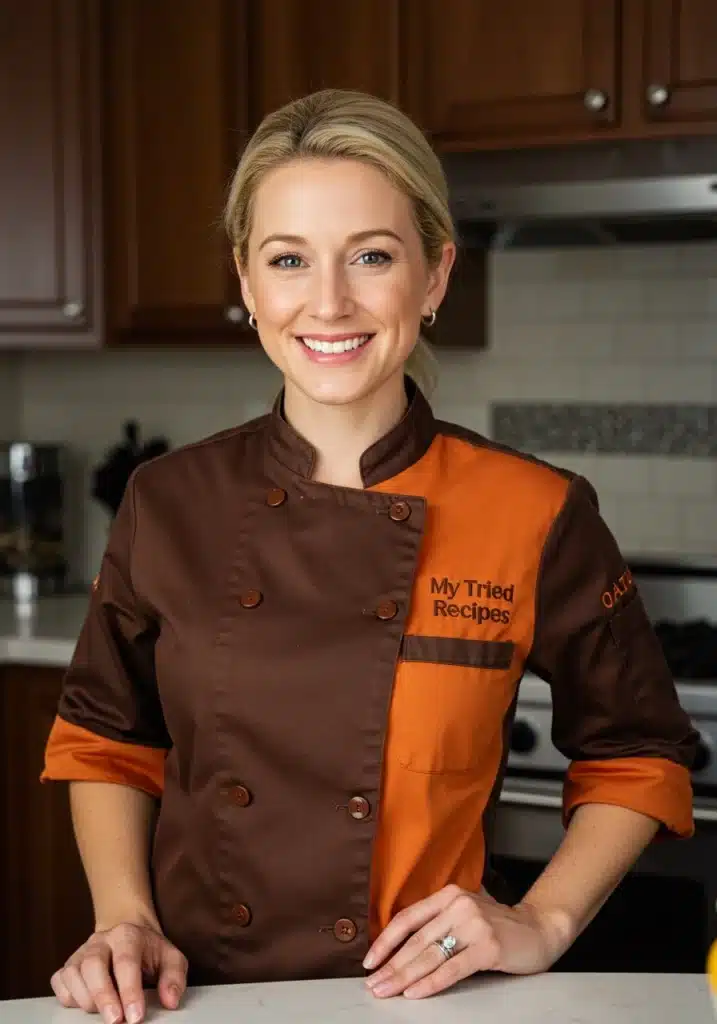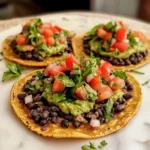It’s one of those recipes that sneaks up on you. I first threw together a version of this One-Pot Veggie Couscous on a whim, staring into a fridge that seemed both full and empty at the same time – you know the feeling. I needed something quick, something that wouldn’t leave me with a mountain of dishes, and something that would, hopefully, get a thumbs-up from everyone at the table, including my notoriously picky eater. I grabbed some couscous, a can of chickpeas, and a colorful array of vegetables that were nearing their use-by date. The aroma that filled the kitchen as the spices toasted and the vegetables softened was the first sign I was onto a winner. When I finally spooned it onto plates, garnished with a handful of fresh parsley from the garden, the vibrant colors alone were a feast for the eyes. The real test, of course, was the taste. My partner, usually a meat-and-potatoes kind of guy, went back for seconds. My little one, after some initial suspicion, declared the “tiny pasta balls” to be “yummy!” Since that first successful experiment, this One-Pot Veggie Couscous has become a beloved staple in our household. It’s my go-to for busy weeknights, a reliable crowd-pleaser when friends come over, and even a fantastic option for meal prepping lunches. The beauty of it lies in its simplicity, its versatility, and the sheer explosion of flavor and texture you get from such humble ingredients, all cooked together in a single pot. It’s a dish that proves healthy eating can be incredibly satisfying, effortless, and, most importantly, delicious.
Ingredients
- 1 tablespoon Olive Oil: Extra virgin, for sautéing and adding a touch of fruity richness.
- 1 medium Onion: Finely chopped, forming the aromatic base.
- 2 cloves Garlic: Minced, for that essential pungent kick.
- 1 large Carrot: Peeled and diced into small, uniform pieces for even cooking and sweetness.
- 1 medium Zucchini: Diced, adding a tender bite and subtle flavor.
- 1 Red Bell Pepper: Cored, seeded, and diced, for a pop of color and sweet crunch.
- 1 Yellow Bell Pepper: Cored, seeded, and diced, contributing more sweetness and visual appeal.
- 1 teaspoon Ground Cumin: For earthy, warm notes.
- 1 teaspoon Ground Coriander: Adds a bright, citrusy-floral aroma.
- ½ teaspoon Turmeric Powder: For a beautiful golden hue and mild, peppery flavor.
- ¼ teaspoon Cayenne Pepper (optional): For a touch of gentle heat, adjust to your preference.
- ½ teaspoon Smoked Paprika: Lends a deep, smoky flavor dimension.
- 1 (15-ounce) can Chickpeas: Rinsed and drained, providing plant-based protein and a creamy texture.
- 1 ½ cups Vegetable Broth: Low sodium, to control the saltiness and hydrate the couscous.
- 1 cup Whole Wheat Couscous (or regular): Uncooked, the star of the dish that cooks directly in the pot.
- ½ cup Frozen Peas: Added towards the end for a burst of sweetness and color.
- Zest and Juice of ½ Lemon: For a fresh, zesty finish that brightens all the flavors.
- ¼ cup Fresh Parsley or Cilantro: Chopped, for garnish and an added layer of freshness.
- Salt and Black Pepper: To taste, for seasoning throughout the cooking process.
Instructions
- Sauté Aromatics: Heat the olive oil in a large pot or Dutch oven over medium heat. Add the chopped onion and sauté for 3-4 minutes, until softened and translucent. Stir in the minced garlic and cook for another minute until fragrant, being careful not to burn it.
- Cook Harder Vegetables: Add the diced carrots to the pot. Cook for 5-7 minutes, stirring occasionally, until they begin to soften slightly. Carrots take the longest, so giving them a head start is key.
- Add Softer Vegetables and Spices: Stir in the diced zucchini and bell peppers. Cook for another 4-5 minutes, until the vegetables are tender-crisp. Now, add the ground cumin, ground coriander, turmeric powder, cayenne pepper (if using), and smoked paprika. Stir well to coat the vegetables and cook for 1-2 minutes, allowing the spices to toast and release their aromas. This step is crucial for developing deep flavor.
- Incorporate Chickpeas and Broth: Add the rinsed and drained chickpeas to the pot. Pour in the vegetable broth. Season with salt and black pepper to your liking. Bring the mixture to a gentle simmer.
- Cook the Couscous: Once simmering, stir in the uncooked couscous. Ensure it’s mostly submerged in the liquid. Cover the pot tightly with a lid, remove from the heat, and let it stand for 5-7 minutes, or according to the couscous package directions. The steam trapped inside will cook the couscous perfectly. Do not lift the lid during this time.
- Add Peas and Finish: After the resting time, remove the lid. The couscous should have absorbed all the liquid and be tender. Add the frozen peas. Fluff the couscous gently with a fork, incorporating the peas. The residual heat will cook the peas through in a minute or two.
- Brighten and Garnish: Stir in the fresh lemon zest and lemon juice. Taste and adjust seasoning if necessary (more salt, pepper, or lemon juice). Serve immediately, garnished generously with fresh chopped parsley or cilantro.
Nutrition Facts
- Servings: 4-6 servings
- Calories per serving (approximate for 1 of 6 servings): 350-400 kcal (This can vary based on exact ingredient sizes and brands).
- Protein: Approximately 12-15g per serving, primarily from chickpeas and whole wheat couscous, supporting muscle maintenance and satiety.
- Fiber: Approximately 10-13g per serving, excellent for digestive health and promoting fullness, thanks to the whole grains and vegetables.
- Vitamin C: High, significantly contributing to daily needs from bell peppers, peas, and lemon, boosting immunity and acting as an antioxidant.
- Iron: A good source, particularly from chickpeas and enriched couscous, important for oxygen transport and energy levels.
- Low Saturated Fat: Primarily uses heart-healthy unsaturated fats from olive oil.
Preparation Time
- Total Time: Approximately 30-35 minutes
- Prep Time (chopping vegetables, measuring): 15-20 minutes
- Cook Time: 15 minutes
This quick turnaround makes it an ideal candidate for busy weeknight dinners when time is of the essence but you still crave a wholesome, flavorful meal.
How to Serve
This One-Pot Veggie Couscous is incredibly versatile and can be served in numerous delightful ways:
- As a Standalone Main Course:
- Serve warm directly from the pot into bowls.
- Garnish generously with fresh herbs like parsley, cilantro, or even a sprinkle of fresh mint.
- A dollop of plain Greek yogurt or a plant-based alternative (like unsweetened coconut yogurt or cashew cream) on top can add a lovely creamy coolness.
- A drizzle of good quality extra virgin olive oil right before serving enhances the richness.
- With Added Toppings for Texture and Flavor:
- Sprinkle with toasted nuts like slivered almonds, pine nuts, or chopped pistachios for a delightful crunch.
- Toasted pumpkin seeds or sunflower seeds also work wonderfully.
- Crumbled feta cheese or goat cheese, if not keeping it vegan, adds a salty, tangy dimension.
- A few Kalamata olives or sun-dried tomatoes can introduce a briny, umami punch.
- A sprinkle of red pepper flakes for those who enjoy extra heat.
- As a Side Dish:
- It pairs beautifully with grilled halloumi cheese.
- Serve alongside grilled chicken, fish (like salmon or cod), or lamb kofta for a more substantial meal.
- It can accompany falafel or veggie burgers.
- For Meal Prep or Light Lunches:
- Portion into individual containers for easy grab-and-go lunches throughout the week. It’s delicious warm or even at room temperature.
- Pack with a small container of lemon wedges to squeeze over just before eating.
- Creative Presentations:
- Stuff into hollowed-out bell peppers or tomatoes and bake briefly for an elegant presentation.
- Serve in lettuce cups for a lighter, carb-conscious option.
Additional Tips
- Vegetable Versatility: Don’t feel restricted by the vegetables listed. This recipe is incredibly forgiving. Try adding diced sweet potatoes (add them with the carrots as they take longer to cook), mushrooms (add with zucchini/peppers), spinach or kale (stir in at the very end until wilted), or even chopped broccoli or cauliflower florets. It’s a fantastic way to use up whatever veggies you have on hand.
- Spice Level Customization: Adjust the heat to your preference. For a milder dish, omit the cayenne pepper entirely. For more heat, increase the cayenne, add a pinch of red pepper flakes along with the other spices, or even stir in a teaspoon of harissa paste with the broth for a North African kick.
- Boost the Protein: While chickpeas provide good plant-based protein, you can enhance it further. Consider adding a can of rinsed and drained lentils along with the chickpeas. For a non-vegetarian version, stir in cooked shredded chicken or diced cooked sausage towards the end, or serve topped with grilled shrimp.
- Broth Choice Matters: Using a good quality, flavorful vegetable broth makes a noticeable difference. If you don’t have vegetable broth, chicken broth can be used if you’re not aiming for a vegetarian/vegan dish. In a pinch, even water can work, but you might need to adjust the seasoning more significantly, perhaps adding a bit of soy sauce or nutritional yeast for umami.
- Couscous Varieties: This recipe works well with both regular (Moroccan) couscous and whole wheat couscous. Pearl couscous (Israeli couscous) can also be used, but it requires a different cooking method and longer cooking time (simmer it in the broth for about 8-10 minutes before adding other quick-cooking ingredients or cook it separately).
- Don’t Overcook the Couscous: The key to fluffy couscous is to let it steam off the heat. Once you add the couscous to the simmering broth, cover it, remove it from the heat immediately, and resist the urge to peek for the full 5-7 minutes. Overcooking or too much stirring can make it gummy.
- Make-Ahead & Storage: This dish is excellent for meal prep. Store leftovers in an airtight container in the refrigerator for up to 3-4 days. It reheats well in the microwave or gently on the stovetop with a splash of water or broth to prevent drying out. It’s also surprisingly good cold or at room temperature, making it great for packed lunches.
- Finishing Touches for Extra Zing: Beyond lemon juice and fresh herbs, consider a drizzle of tahini dressing, a sprinkle of za’atar spice blend, or a few drops of high-quality balsamic glaze right before serving to elevate the flavors even more.
FAQ Section
Q1: Can I make this recipe gluten-free?
A1: Yes, absolutely! Couscous is made from wheat, so it’s not gluten-free. To make this dish gluten-free, simply substitute the couscous with an equal amount of quinoa. You’ll need to adjust the cooking method slightly: add the quinoa with the broth, bring to a boil, then reduce heat, cover, and simmer for about 15-20 minutes, or until the liquid is absorbed and the quinoa is cooked. Millet or even short-grain brown rice (which will take significantly longer) could also work, but cooking times and liquid ratios will vary.
Q2: Can I use frozen vegetables instead of fresh?
A2: Yes, frozen vegetables can be a convenient option. For vegetables like peas, they are typically added towards the end as they cook quickly. For heartier frozen vegetables like carrots or bell pepper strips, you might not need to cook them as long as their fresh counterparts. Add them after sautéing the onions and garlic, and cook until heated through and tender-crisp. Be mindful that frozen vegetables can release more water, so you might need to adjust the broth slightly, though often it balances out.
Q3: How long will this One-Pot Veggie Couscous last in the fridge?
A3: Stored properly in an airtight container, this dish will last for 3-4 days in the refrigerator. The flavors can even meld and improve by the next day. It’s perfect for leftovers or meal prepping.
Q4: Can I prepare parts of this dish ahead of time?
A4: Yes, you can! To save time, you can chop all the vegetables (onion, garlic, carrots, zucchini, bell peppers) a day or two in advance and store them in an airtight container in the fridge. You can also pre-measure your spices into a small bowl. This makes the actual cooking process much quicker on a busy day.
Q5: What if I don’t have all the spices listed?
A5: While the combination of cumin, coriander, turmeric, and smoked paprika creates a wonderful flavor profile, you can still make a delicious dish with what you have. Cumin is quite central to the flavor. If you’re missing one or two, you can try increasing the amounts of the others slightly, or use a pre-made spice blend like a mild curry powder or a Moroccan spice blend (ras el hanout) as a substitute, starting with about 1-2 teaspoons and adjusting to taste.
Q6: Is this recipe vegan?
A6: Yes, as written, this recipe is naturally vegan, provided you use vegetable broth and avoid any non-vegan garnishes like dairy yogurt or feta cheese. It’s a fantastic, hearty plant-based meal.
Q7: Can I add meat or other animal protein to this dish?
A7: Certainly! If you’d like to add meat, you could brown some diced chicken breast or thigh pieces, or ground lamb/beef, after sautéing the onions and before adding the other vegetables. Remove the cooked meat, proceed with the recipe, and then stir the cooked meat back in when you add the chickpeas or at the very end. Alternatively, serve the veggie couscous as a side to grilled fish, shrimp, or chicken.
Q8: My couscous turned out mushy/clumpy. What went wrong?
A8: This usually happens for a couple of reasons:
* Too much liquid: Ensure you’re using the correct ratio of couscous to broth (typically 1 cup couscous to 1 to 1.5 cups liquid, depending on the brand and type – this recipe uses 1.5 cups broth for 1 cup couscous which also accounts for some evaporation and absorption by veggies).
* Overcooking or simmering: Couscous doesn’t need to be simmered. Once the liquid is boiling (or simmering, in this recipe, with the veggies), stir in the couscous, cover tightly, and remove from the heat. Let it steam.
* Not fluffing properly: Once cooked, use a fork to gently fluff the couscous grains, separating them. Avoid over-stirring, which can make it pasty.
* Lid peeking: Resist the urge to lift the lid while the couscous is steaming, as this releases the steam needed for proper cooking.






